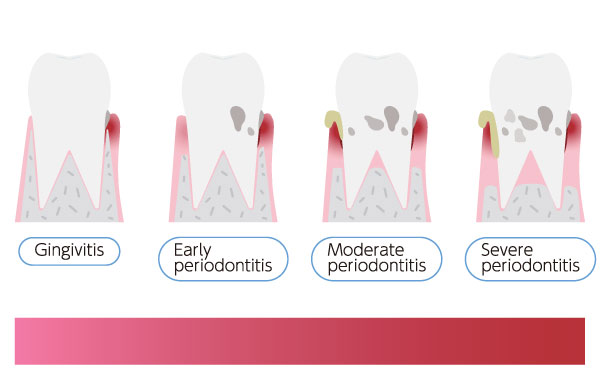Protecting Your Smile: Early Intervention for Gum Disease
Gum disease, also known as periodontal disease, is a progressive condition that can lead to tooth loss and other serious health complications if left untreated. Gum disease advances through distinct stages, beginning with gingivitis and evolving into periodontitis.
Recognizing the stages of periodontal disease and its symptoms is vital for early detection and effective treatment. To book an appointment, contact our dentist in Tacoma, WA, by calling (253) 761-5422.

Gum Disease Stages
Gingivitis
The initial stage of periodontal disease is known as gingivitis, a mild inflammation of the gums caused by plaque accumulation around the teeth. Common symptoms of gingivitis include:
- Bleeding gums
- Swollen gums
- Tender or sensitive gums
- Bad breath
- Receding gums
- Gum sensitivity
- Changes in gum texture
Fortunately, gingivitis can often be reversed with proper oral hygiene practices, such as brushing your teeth twice daily, flossing regularly, and attending routine dental cleanings.
If you’ve noticed signs of gingivitis, schedule a dental appointment promptly. With early intervention, gingivitis can be effectively treated before it progresses to more severe stages of gum disease.
Early Periodontitis
If gingivitis isn’t addressed, it can advance to early periodontitis, characterized by a more significant infection affecting the bone supporting the teeth.
Symptoms of early periodontitis include:
- Persistent bad breath
- Bleeding gums
- Swollen or red gums
- Gum recession
- Tooth Sensitivity
- Loose teeth
- Formation of periodontal pockets
At this stage, bacteria have started to infiltrate deeper layers of gum tissue and the surrounding bone, leading to irreversible damage and bone loss.
To treat early periodontitis, dentists may recommend scaling and root planing, a procedure that involves removing plaque and tartar buildup from beneath the gum line and smoothing the tooth root surfaces.
Moderate Periodontitis
Moderate periodontitis is the third stage of gum disease, marked by substantial bone loss and gum recession. Other symptoms include:
- Deep gum pockets
- Gum swelling and redness
- Tooth migration or shifting
- Gum abscesses
- Chronic bad breath
- Changes in the bite
- Pain or discomfort while chewing
Treatment for moderate periodontitis usually involves a combination of scaling and root planing, antibiotic therapy, and possibly surgical intervention. Dentists might suggest a bone graft or guided soft tissue regeneration to help regenerate lost bone and gum tissue.
Advanced Periodontitis
The final stage of gum disease is advanced periodontitis, characterized by severe bone loss and tooth mobility. At this severe stage, teeth may need to be extracted, and extensive reconstructive procedures may be necessary to restore oral health.
Symptoms of advanced periodontitis include:
- Severe pain
- Tooth loss
- Gum inflammation
- Severe gum recession
- Pus discharge and painful abscesses
- Swollen or bleeding gums
It’s essential to seek professional dental care if you’re experiencing symptoms of advanced periodontal disease.

Frequently Asked Questions
Can gum disease be cured?
While the more severe stages of gum disease cannot be entirely cured, they can be effectively managed and controlled with proper oral hygiene and professional dental care. With timely intervention, gingivitis can often be reversed, and the advancement of gum disease can be slowed or halted.
How long until gum disease is irreversible?
Gum disease reaches an irreversible stage during the second and third phases. To prevent moderate periodontitis or advanced periodontitis, it is crucial to maintain good oral hygiene and have regular dental checkups.
Can gum disease affect my overall health?
Yes, there’s increasing evidence suggesting that gum disease may be connected to various systemic health issues, such as heart disease, stroke, and diabetes. This is because the bacteria responsible for gum disease can enter the bloodstream and potentially cause inflammation throughout the body. Taking care of your gum health is essential for maintaining your overall health and well-being.
How fast does periodontal disease progress?
Periodontal disease progresses gradually yet steadily. Within just four days, plaque buildup can reach its peak, making the signs of gingivitis visible by day five. If gingivitis isn’t treated, more advanced periodontal disease can develop within weeks.
Concerned About Gum Disease? Book a Consultation Today!
If you’re noticing symptoms of gum disease or wish to learn more about gum disease prevention methods, make an appointment with our Tacoma dentist. Don’t ignore gum disease, as it can lead to significant health issues if left untreated.
Contact us at (253) 761-5422 to book your appointment and begin your journey toward optimal oral health. We’re delighted to serve patients in Tacoma, Lakewood, Puyallup, Federal Way, Gig Harbor, and University Place.





















